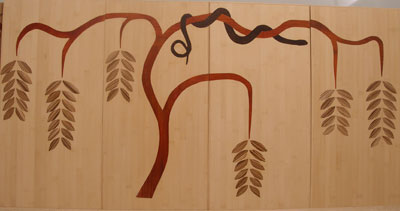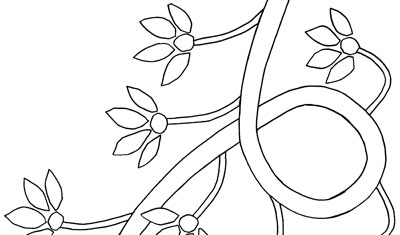
Bob Baldwin’s beautiful and unusual kitchen cabinet doors, created with the help of Scan2CAD raster to vector conversion software. © Bob Baldwin.
In his previous job as the senior designer for a big cabinet company, Bob Baldwin had always felt that there was room for more innovation in cabinet design. He is now pursuing his vision. With the help of Scan2CAD raster to vector conversion software Bob is giving life to his own kitchen cabinet designs.
“Little is being done in cabinetry in general and kitchen design in particular that wasn’t around 40 years ago” says Bob. As an example, he cites door panels that remain much the same in their choice of wood species and finishes. “There was some innovation about 20 years ago with what we call European style cabinetry in the USA but other than not having face frames and offering white cabinets, it’s really not a huge change” he says.
In Bob’s contemporary kitchen designs, cabinet doors become a canvas for his art. “I want to use flat panel doors to bring color, shape, and design into the kitchen” he says.
“Imagine a flowering vine snaking its way across the upper cabinet doors, or a flock of birds or butterflies or clouds or a garden scene on the base cabinets or a colorful landscape. This is not being done, and I think it should be. It would bring color into the kitchen and make every kitchen unique. Instead of painting or printing such scenes, I want to use inlayed stained wood veneers to make art with a more permanent feel than most disposable kitchen designs. The wood grain would add to the effect.”
Bob uses solid bamboo flat panels for the doors and drawer fronts because bamboo is not an endangered wood species, unlike some of the exotic tropical woods, and because its fine grain acts as a non-intrusive backdrop for his designs’ inlays.
The conversion of Bob’s free-flowing artistic designs into veneer inlays presented him with a problem. Like many CNC operators using a variety of cutting machines today, Bob simply wanted to draw a design, take a digital photo of it and then have his CNC router do the rest. Bob thought he would find a CAM product to do this. “There isn’t one” he says. “In my search, I populated CNC chat rooms with numerous questions asking if anyone knew how to do what I wanted. The general consensus was that it was not do-able – which explains why it wasn’t being done. This thrilled me – I love a challenge!”
Determined to automate the process, Bob looked to raster to vector conversion software as a solution. After a disappointing experience with another product, Bob downloaded the Scan2CAD Trial. He quickly decided that “Scan2CAD is better”. During his Scan2CAD trial period he received technical support from Softcover’s Andrea Tribe. Scan2CAD enjoys growing success in the CNC and CAD/CAM market. Her knowledge of vectorizing shapes for CNC and CAD/CAM applications gave Bob the start he needed. “Andrea provided good support” he said. “She was patient, knowledgeable and responsive”.
After discussing his requirement by email, Bob decided to follow Andrea’s advice and use a sharp, fine point black pen to trace around the marquetry outlines instead of photographing them. This allowed Scan2CAD to vectorize the defined line detail that was drawn to the correct scale and aspect ratio.
“I’m getting great vectors now” Bob emailed Andrea, but worried that “they don’t show up in my Vectrics VCarvePro CAM program”.
The non-appearance of Bob’s vectors was not due to any limitation in the Scan2CAD 7 day full-working evaluation. Rather, it was because many CNC programs, including Bob’s Vectrics VCarvePro, do not support the importation of Bezier curves, something he had used at Andrea’s recommendation because they give a smooth fit to free-flowing, organic outlines. However, before such a vectorized DXF file can be exported into a CNC program, the tight-fitting bezier curves must first be saved as arcs if the DXF file is to be successfully read into most CNC machines. Once Bob had saved his Bezier curves as arcs, he was pleased to see his artistic designs appear as vector data in his Vectrics VCarvePro CAM program for the first time.
Scan2CAD raster to vector conversion software has provided Bob with a practical solution, one which many in the CNC community said did not exist and could not be done.
Bob now proposes to produce his designs as doors which can be fitted to any standard size of kitchen cabinet. “Cabinet boxes are large and hard to ship,” he says, “but cabinet doors aren’t. Also, cabinet boxes are all the same – you can hang just about any door on them. That means that I can ship my door design anywhere, and they can be installed on someone else’s cabinets. I intend to sell from a website and never have to leave my shop to do installations”.


